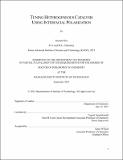Tuning Heterogeneous Catalysis Using Interfacial Polarization
Author(s)
Ryu, Jaeyune
DownloadThesis PDF (8.274Mb)
Advisor
Surendranath, Yogesh
Terms of use
Metadata
Show full item recordAbstract
A plethora of emerging energy conversion technologies employ heterogeneous catalysis at solid-liquid interfaces, ranging from faradaic electrocatalysis and nonfaradaic thermochemical catalysis. Unlike for a gas-solid interface, charge transfer events at a solid-liquid interface can polarize the interface, resulting in a local environment at the active site that is radically distinct from the environment in the bulk liquid phase. Thus, unraveling the influence of electrical polarization on solid-liquid interface is a critical prerequisite for elucidating reactivity trends and for the rational design of new catalysis. Accordingly, this dissertation aims to understand (Part I) and control (Part II) the interfacial polarization effects during heterogeneous catalysis.
Part I of this thesis establishes a quantitative correlation between the degree of interfacial polarization and the perturbation of the local interfacial microenvironments under the conditions of catalysis. In particular, we examine spontaneous and driven polarization mechanisms that give rise to interfacial electrostatic gradient (Chapter 2) and non-equilibrium concentration profiles (Chapter 3), respectively. Exploiting a surface-specific nonfaradaic reaction probe to sample the local activity of protons, which serve both as free ionic charge carriers and reactants/products of proton-coupled electron transfer reactions, we quantify interfacial electrostatic field strength and non-equilibrium pH gradient within molecular length scales from the catalytic surface.
Leveraging the fundamental knowledge of interfacial polarization mechanisms gained in Part I, Part II of this thesis establishes a general mechanistic framework for exploiting interfacial polarization to mediate and promote thermochemical catalysis. Specifically, we demonstrate that thermochemical aerobic oxidation catalysis in water is mediated via spontaneous interfacial polarization induced by the coupling of constituent electrochemical half-reactions (Chapter 4). Additionally, exploiting driven-polarization to induce the non-equilibrium local pH swing, we show that Pd-catalyzed thermochemical CO₂ hydrogenation to formate can be dramatically promoted with modest electrical bias under mild reaction conditions (Chapter 5).
Date issued
2021-09Department
Massachusetts Institute of Technology. Department of ChemistryPublisher
Massachusetts Institute of Technology